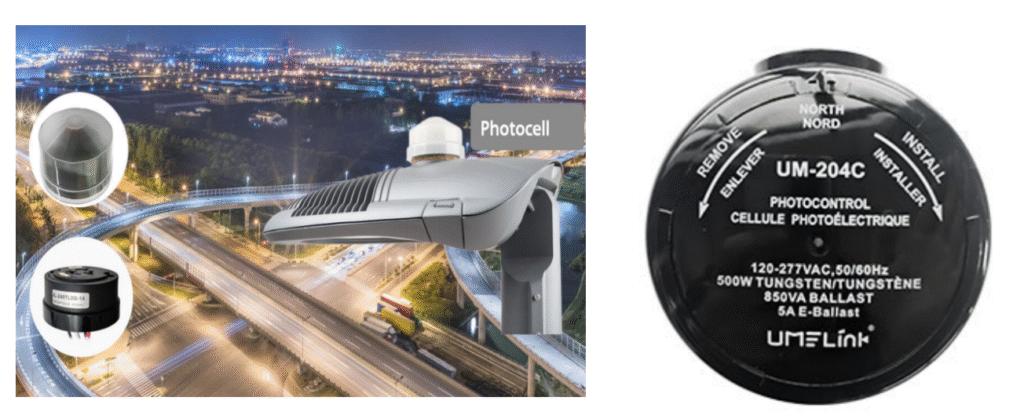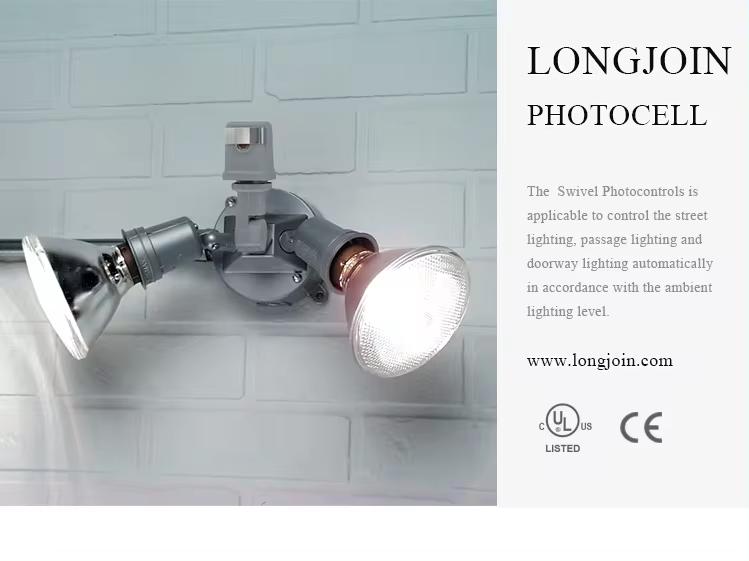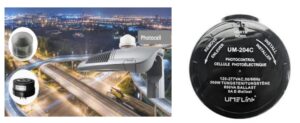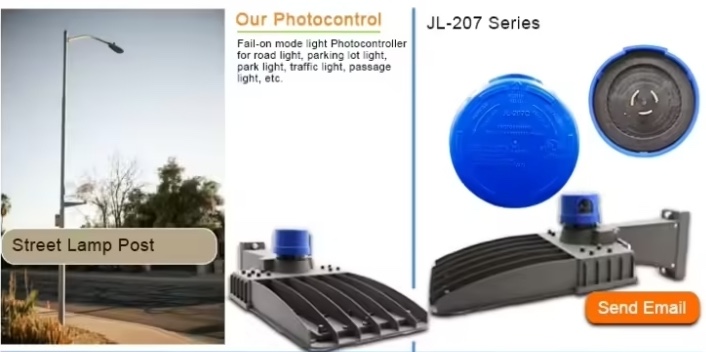مخطط تفصيلي
- مقدمة
- Why Compare مقابس التحكم الضوئي and Motion Sensors for Outdoor Lighting in 2025?
- كيف مفاتيح الخلايا الضوئية Control Outdoor Lighting Automatically?
- How Do Motion Sensors Detect and Activate Lights Efficiently?
- What Are the Key Differences Between Photocells and Motion Sensors?
- In Which Scenarios Should You Use Photocells or Motion Sensors?
- Can You Combine وحدات التحكم الضوئية and Motion Sensors for Smarter Lighting?
- What Smart Lighting Solutions Does Long‑Join Offer for 2025?
- الكلمات النهائية

Photocells and motion sensors are currently the most employed means for smart lighting. Both help save energy. However, they work in different ways.
وحدات التحكم الضوئية respond to natural light, and the motion sensors react to movement. Choosing the right one needs careful consideration of where and how you use them.
This guide breaks down each. Whether you’re planning streetlights or securing a warehouse, this comparison will help you decide.
Why Compare مقابس التحكم الضوئي and Motion Sensors for Outdoor Lighting in 2025?
Photo Sensor vs Motion Sensor
This light‑sensing device turns the lights on at dusk and off at dawn automatically. It responds solely to ambient light levels.
A motion sensor detects movement. It can use passive infrared or microwave technology. Lights activate only when motion is present.
Why Does This Debate Matter?
Rising energy costs
LED lighting is cheaper, but power prices are rising. Smart controls reduce waste. Cities and businesses need to cut OPEX now rather than later.
Smart city demands
Urban governments around the globe now require lighting that adapts to traffic and daylight conditions. Systems must support IoT, remote dimming, and data-driven control.
Evolving security needs
Public safety standards now favour lighting that responds in real time to pedestrian or vehicle presence. This creates safer walkways and parking zones.
Why Compare Them Head‑to‑Head?
Because each technology delivers different strengths:
- وحدات التحكم في الإضاءة offer simple, passive control that curbs light pollution.
- Motion sensors enable burst usage—only active when needed, lowering idle power and improving targeted security.
Furthermore, Many countries now enforce minimum energy performance standards. This requires a rapid transition to LED systems by 2025. Governments and corporations seek large-scale carbon cuts. Smart lighting helps reduce emissions while meeting ESG goals.
كيف مفاتيح الخلايا الضوئية Control Outdoor Lighting Automatically?

وحدات تحكم في إنارة الشوارع utilize photoresistors to manage lighting. Once ambient light drops below a preset threshold, the circuit closes. The lights switch on automatically. At dawn, increased light opens the circuit, and lights turn off. This ensures lighting aligns precisely with natural light cycles.
حالات الاستخدام المثالية
مفاتيح مستشعر الضوء are good to go in lighting applications that don’t require motion-based triggers. Ideal environments include:
- Street lights along urban roads and highways
- Pathway lighting in parks and campuses
- Large parking lots and exterior security perimeters
الفوائد الرئيسية
● Energy Efficiency
Lights operate only during dark hours. This avoids energy wastage in daylight. Yields can be boosted further by combining them with LED fixtures.
● Minimal Maintenance Required
Once installed, photocells work automatically without scheduling or remote control. No programming, no operations.
● Passive, Reliable Control
No moving parts. Purely light-driven switching reduces failure risk. Performance remains steady across seasons.
● Supports Sustainability Goals
Automatically cutting off daytime energy usage helps meet regulatory and ESG objectives. Reduces carbon footprint in urban lighting.
How Do Motion Sensors Detect and Activate Lights Efficiently?
Motion sensors offer strong advantages where intermittent yet precise lighting is needed. They deliver light exactly when it matters—efficiently and smartly. Commonly, they use one or more of the technologies discussed below to detect activity outside.
● Passive Infrared
PIR sensors measure changes in infrared radiation emitted by warm bodies—like people—relative to the colder background. They trigger the light when a moving heat source crosses their field of view.
● Microwave
They emit electromagnetic waves and listen for Doppler shifts in the reflection. They can detect movement through non-metallic objects, walls, or glass.
● Dual-technology
These products combine both PIR and microwave. Both sensors must trip to activate, significantly reducing false triggers.
Where Motion Sensors Work Best
Ideal settings make the most of their targeted activation. Here are some spaces where they are best suited.
- Alleyways
- Back entrances
- Building perimeters
- Warehouse loading zones
These are typically areas with intermittent foot or vehicle traffic where proactive illumination enhances safety without wasting power.
فوائد
- Real-time activation ensures lights switch on within moments of movement. They turn off after a preset delay, minimizing idle energy.
- Sudden illumination deters intruders and alerts nearby observers. Integration with alarms or cameras can enable instant alerts.
- Because lights remain off unless needed, you save energy over long overnight periods. Studies show reductions in electricity usage of up to 40% in smart urban.
- PIR sensors consume minimal power (often under 1 W), while microwave sensors use slightly more. PIR-based units are especially suitable for solar or battery-powered installations.
What Are the Key Differences Between Photocells and Motion Sensors?
| ميزة | Photocell (Dusk-to-Dawn) | Motion Sensor (PIR/Microwave) |
| Trigger Mechanism | Ambient light detection | كشف الحركة |
| Activation Time | Nightfall to sunrise | Only when movement is sensed |
| Energy Profile | Moderate (long use) | Very low (intermittent use) |
| تكلفة التركيب | Simple and low-cost | Slightly higher, more wiring |
| Ideal Zones | Public lighting, roads | Entrances, corridors, alleys |
In Which Scenarios Should You Use Photocells or Motion Sensors?
| مجال التطبيق | Recommended Sensor Type | Main Goal | Typical Activation Method |
| Urban Roadways | الخلية الضوئية | Energy saving | Ambient light detection |
| Residential Backyards | مستشعر الحركة | Security & automation | Motion within detection range |
| Parks & Pathways | Hybrid | Safety & efficiency | Light + motion combined logic |
| Remote Parking Lots | مستشعر الحركة | Targeted illumination | Triggered by vehicle movement |
إنارة الشوارع
أجهزة استشعار الخلايا الضوئية are more recommended here. They work best where lighting is needed consistently through the night. These are the most cost‑effective for long-duration coverage with little human input.
Security Lighting
Motion sensors shine here: they only activate light when movement is detected. Their targeted activation improves security while minimizing idle energy use.
Smart Cities
Hybrid systems combine photocell base-level illumination with motion-triggered boosting. These adaptive systems dim when no activity is present and brighten on demand. Large pilots in Europe and North America show savings of up to 60–85% energy compared to static lighting systems.

Extreme Weather
In such environments, photocells might trigger for long hours with no benefit. Meanwhile, motion sensors may miss slow or static movement in large zones. In such conditions, careful sensor placement or zoning—or even fallback scheduling—ensures reliability without excessive energy use.
Can You Combine وحدات التحكم الضوئية and Motion Sensors for Smarter Lighting?
Hybrid lighting systems use photocell control as a dusk‑to‑dawn lighting backbone. A motion sensor adds brightness only when movement is detected. The light stays dim at night but jumps to full output on motion, then returns to baseline after preset delay.
This balances safety and savings in one system. Smart city pilots across Europe. Sheffield and Oslo report 20–45% energy savings.
الفوائد الرئيسية
- Lower energy consumption due to smart lighting management.
- Improved visibility and security because motion-triggered brightness reduces dark zones.
- Greater reliability—Photocells avoid missed nighttime illumination; motion prevents unnecessary full-on use.
- Optimal for smart city deployment—supports zoning, dimming, and remote control.
| ميزة | Photocell Only | Motion Sensor Only | Hybrid Setup (Both) |
| كفاءة الطاقة | عالي | معتدل | عالية جدًا |
| Real-Time Adaptivity | قليل | عالي | عالية جدًا |
| Initial Installation | Easy | Easy | معتدل |
| Ideal for High Traffic | نعم | نعم | نعم |
| Nighttime Safety | جيد | عالي | ممتاز |
What Smart Lighting Solutions Does Long‑Join Offer for 2025?
Long‑Join delivers robust, future‑proof lighting controls tailored for smart cities, municipalities, integrators, and OEMs.
JL‑203C & JL‑243C
These are ANSI C136.41‑compliant twist‑lock dusk‑to‑dawn photocontrols. JL-243C includes a built‑in surge arrester (≈ 40 kA / 640 J) and LED decay compensation for extended reliability.
The series supports multi‑voltage input (90–305 VAC), IP65 (IP67 optional), with microprocessor control, infrared‑filtered sensors, and optional metal‑armor for durability.
Motion‑Sensor Compatible & Modular Designs
Long‑Join offers JL‑7xx series photocontrollers that support light‑sensing plus microwave or PIR detection.
These modules offer automatic brightness adjustment and remote manageability for flexible deployment in varied outdoor environments.
IoT‑Ready
Long‑Join is a Zhaga Consortium member and produces controllers conforming to Zhaga Book 18 standards. Their زاغا-D4i-certified modules enable plug‑and‑play compatibility and future‑proof upgrade paths in smart city lighting ecosystems.
Further, the products also support communication protocols like DALI2.0 (D4i), 0‑10 V, Bluetooth mesh, and wireless protocols: إنترنت الأشياء ضيق النطاق, لورا، و زيجبي.
Designed for B2B
Long‑Join’s solutions are geared for large‑scale deployments, especially smart city streetlight networks and utility grids. Here is a list of their compliance with international certifications.
الكلمات النهائية
Smart lighting requires selecting the right sensor for the right application. Combining photocells and motion sensors can deliver superior performance and energy savings. تشي-سوير provides dependable Long-Join smart photocells built for modern outdoor systems. Explore their solutions to upgrade your lighting infrastructure with confidence.






